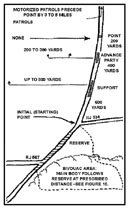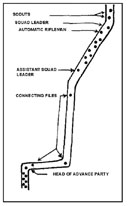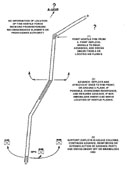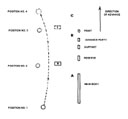
CHAPTER 4
SECURITY MISSIONS
- GENERAL.--Security missions which may be assigned to
a rifle company include the following:
- Support of an advance guard.
- Support of a rear guard.
- Advance or rear guard.
- Flank guard.
- Support of an outpost for a bivouac.
- Part of a general outpost in defensive operations.
- Combat outpost of a front-line battalion in defensive operations.
- March outpost.
A company having a security mission is issued its extra ammunition before beginning the mission, and its weapon carriers usually go with the company except as indicated in paragraph 92c.
- SUPPORT OF ADVANCE GUARD.--
- When a battalion constitutes the advance guard, the leading rifle company will ordinarily be designated as the support. (See FM 100-5.) The mission of the support is to reconnoiter to the front and to provide security for the element following in its immediate rear.
- Upon receipt of the advance guard order, the support commander prepares and issues his own order to his assembled subordinate leaders. The support commander's order usually contains--




